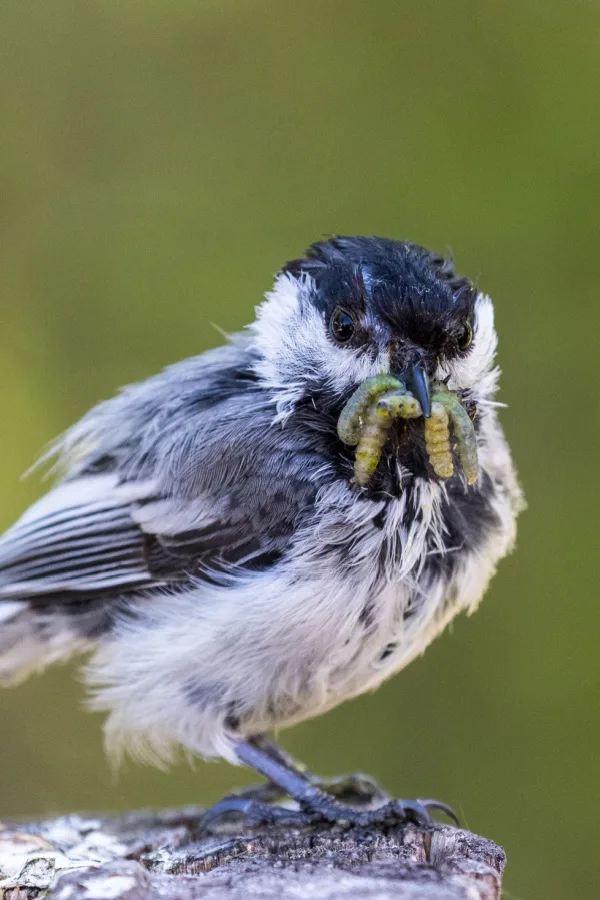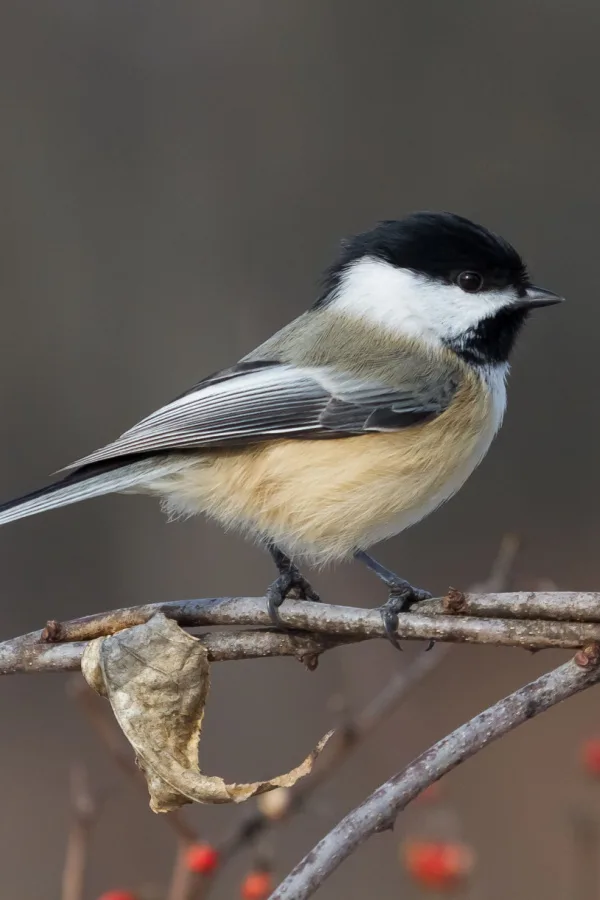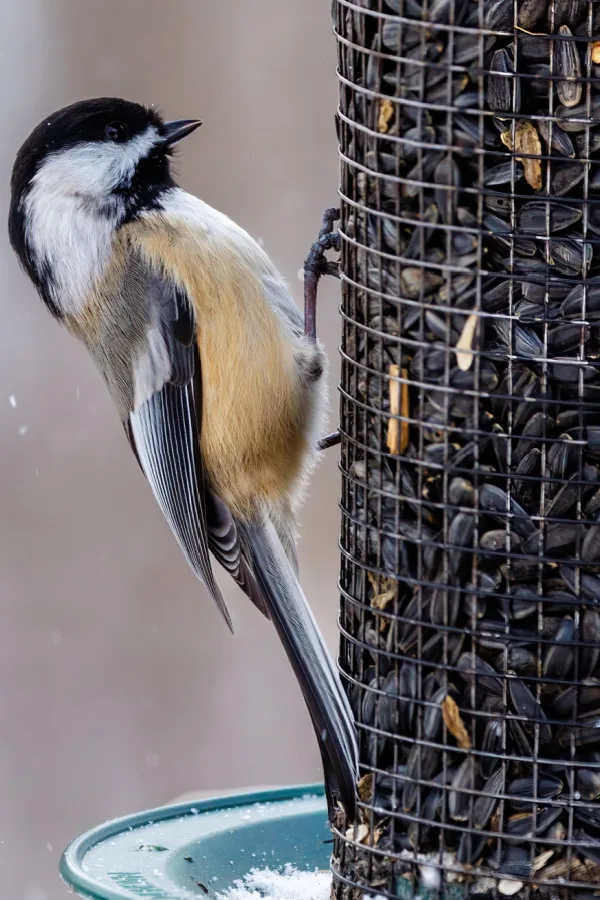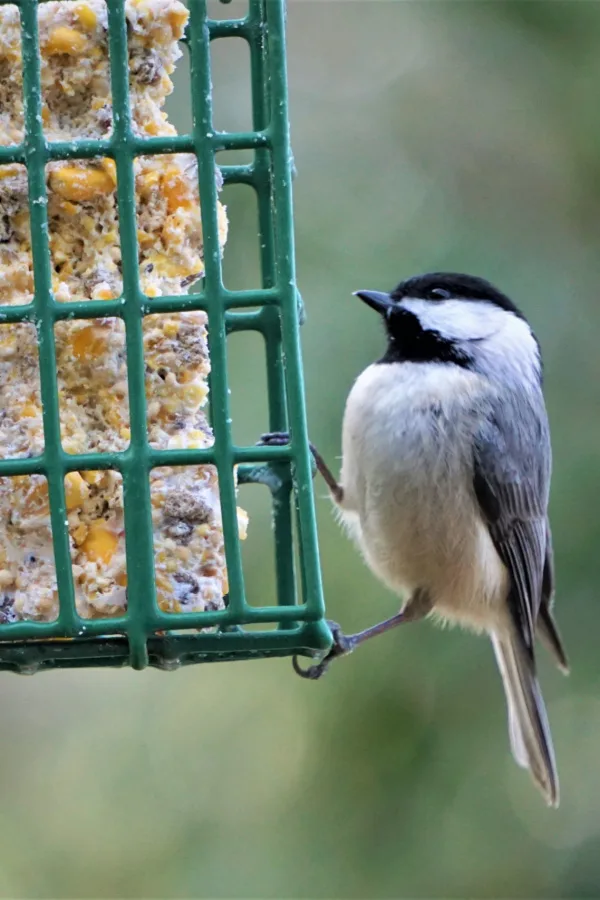Looking for a few tips on how to feed and help keep chickadees alive and thriving during the colder fall and winter months?
These tiny, energetic and friendly birds are a great addition to any property. With their oversized heads and large puffy bodies, chickadees are not only adorable but they also have big personalities to go along with their looks. And are they ever helpful to gardeners with keeping insect populations under control in the spring and summer!
Chickadees are extremely active birds. But because of their high energy movements, they require a lot of food. During the summer, this isn’t an issue since there are plenty of insects and other food to sustain their diet. But in late fall and winter – finding consistent meals can be an issue.

During the spring and summer, chickadees are able to consume as much as 35% of their body weight daily from insects! And when you consider most of those are flies, grubs, beetles, caterpillars or their larva, chickadees are certainly a great natural way to help control the insect population around your property.
However, during the fall and winter months, finding food becomes much more difficult. And that is exactly where supplementing their food can play a pivotal role in their survival. See: How To Help Birds Survive Winter – 3 Ways To Help Birds Survive
By simply providing chickadees with a consistent supply of some of their favorite foods, you can more than help keep them alive through winter – and – of course, have them sticking around to help your garden and flowerbeds even more next spring!
Spotting Chickadees In The Landscape
There are seven different species of chickadees that reside in North America. They all feature different white patches on their cheeks and black throats. Their beaks are short but sharp, which makes them perfect for grabbing bugs or breaking open small seeds. And do those beaks ever chirp!
Chickadees have a distinctive “chick-a-dee-dee” call that gives them their namesake. You can also hear a quieter chatter of “seet” sounds as they contact one another. Their vocal calls to one another are actually what make them a favorite of so many bird watchers and enthusiasts.

Most chickadees are non-migratory birds. While they might travel a couple of miles during colder months when the insects and other food sources are reduced, they typically don’t stray too far from their original nests.
But they are also quite intelligent birds when it comes to sticking around for food. And if they find a consistent source, they are much more likely to call it “home” for good.
How Chickadees Feed During Fall & Winter
Chickadees favorite foods are seeds, berries, and insects. However, chickadees are omnivores, and will resort to eating almost anything during the winter months to stay alive. In a natural setting, about 50% of their winter diet is made up of eggs, larvae, spiders, or hibernating insects.
These items are high in fat content and give the chickadees a lot of calories. The higher fat content helps to keep these petite birds warm and survive the cold winter nights.
Chickadees are constantly searching for food. They use their small beaks to pick out an individual seed from a pile and carry it off to a nearby branch. They then hold the seed with their feet while they pound the shell with their beak to open it.

What really makes chickadees unique is that they will also store food when they find a bit of excess. They will actually stash seeds and berries all around to eat later, much like squirrels. But unlike squirrels that often forget where these items are hidden, chickadees can remember the location.
When Winter Becomes A Problem
The issue with chickadees in the fall and winter is that many of their natural food resources can become scarce. As the cooler weather of fall arrives, most insects either die or begin to hide away. And the fresh sources of berries, seeds and nuts that were so plentiful in the summer begin to dry up as well.
Unfortunately, for chickadees, the fall slow up of food couldn’t come at a worse time. It is in the autumn that they need to build up fat reserves for the winter when food can really become scarce.
But this is exactly where feeding can help – and why you want to start in the fall. By putting out a bird feeder with their favorite, high-calorie seeds and foods, you are helping to increase the likelihood that the chickadees will not only survive the colder months but actually thrive during them.
Even more, it makes it more likely for them to stick around in your landscape to create the next generation of chickadees. A generation that will help to provide you with beautiful songs and help keep your insect population in check next spring and summer. It truly is a win-win situation for both!

What To Feed Chickadees During The Fall And Winter
Black Oil Sunflower Seeds
If you want to attract a big variety of songbirds to your property – including chickadees – then black oil sunflower seeds are the way to go! Black oil sunflower seeds have a higher fat content than other sunflower varieties, making them a favorite among birds.
In addition, black oil seeds are meatier and have thinner shells, which makes it easier for smaller birds like chickadees to crack open. They also help to provide chickadees with plenty of protein, fiber, calcium, vitamin E, potassium, and iron. Affiliate Product Link : Meadow Ridge Farms Black Oil Sunflower Bird Seed, 20-Pound Bag
It’s important to only put out enough black oil sunflower seeds that the chickadees can consume in a couple of days. Sunflower seeds have a high tendency to mold and spoil if they are left out in the elements for too long.

You can feed chickadees sunflower seeds in the shell or out. If you are looking to reduce the amount of mess around your bird feeders, shelled sunflower seeds are the way to go. One thing to keep in mind is that shelled seeds will need to be changed more often – and usually cost more than those in shells.
Peanuts
Another food that is high in fat content and that chickadees love is peanuts. They provide chickadees with a quick and easy source of energy and calories. In addition, peanuts are easy for chickadees to store away for another day.
Do not offer chickadees peanuts in their shells. These tiny birds tend to steer clear of the larger in-shell options and will likely look for another source of food. Instead, offer shelled peanuts whole or even break them up into smaller, bite-sized pieces.
This makes for quick grab-and-go meals, a chickadee’s preferred way to eat. If you really want to make them happy with a treat, you can give them peanut butter as an alternative to whole peanuts.
Either creamy or chunky peanut butter will work well, but the chunky gives them a few more nuts. Choose a brand that has little to no additives or extra ingredients included. Organic peanut butter is the best, or you can create your own homemade peanut butter paste from peanuts.
Bird Suet
Another popular choice to feed chickadees during the fall and winter months is suet. Suet is made up of rendered fat, usually from beef. It is melted down and then formed into blocks or other shapes.

Suet is high in calories and makes an excellent meal for birds during the colder months. You can either purchase pre-made suet blocks or easily make your own. Product Affiliate Link : ST. ALBANS BAY SUET PLUS Suet Cake Variety Packs
Typically, suet is mixed with other grains, seeds, and treats. You can vary these treats to suit the type of bird you want to attract. In the case of chickadees, this would include black oil sunflower seeds, peanuts, mealworms, safflower seeds, millet, and/or cracked corn.
Additional Ways To Keep Chickadees Around In Fall & Winter
In addition to helping provide tasty treats and morsels to chickadees, there are a few other ways you can help lure these birds to your property during fall and winter.
Tube feeders seem to be preferred over other types of feeders for chickadees who like grab-and-go meals. Place the feeder in a location that has natural covering nearby to provide the birds with an area to quickly hide if needed. (Affiliate Product Link: Metal Tube Bird Feeder)
Also, provide chickadees with small birdhouses that have a 1-¼ inch entrance hole. Keep the birdhouse in an area with heavy natural coverings. They will use it for both shelter and warmth in the cold winter months.
No matter what type of treats you feed chickadees this fall and winter, you can sit back and enjoy watching these and other birds flock to your property – providing them with the calories they need and you with great entertainment from the comfort of your home!
Follow Our Facebook Page For Great Gardening Tips And Advice! This Is My Garden Facebook Page
This Is My Garden is a garden website created by gardeners, for gardeners. Jim and Mary Competti have been writing gardening, DIY and recipe articles and books and speaking for over 15 years from their 46 acre Ohio farm. They publish three articles every week, 52 weeks a year. Sign up today to follow via email, or follow along!
